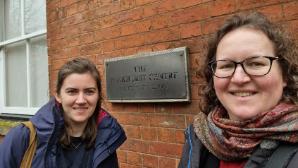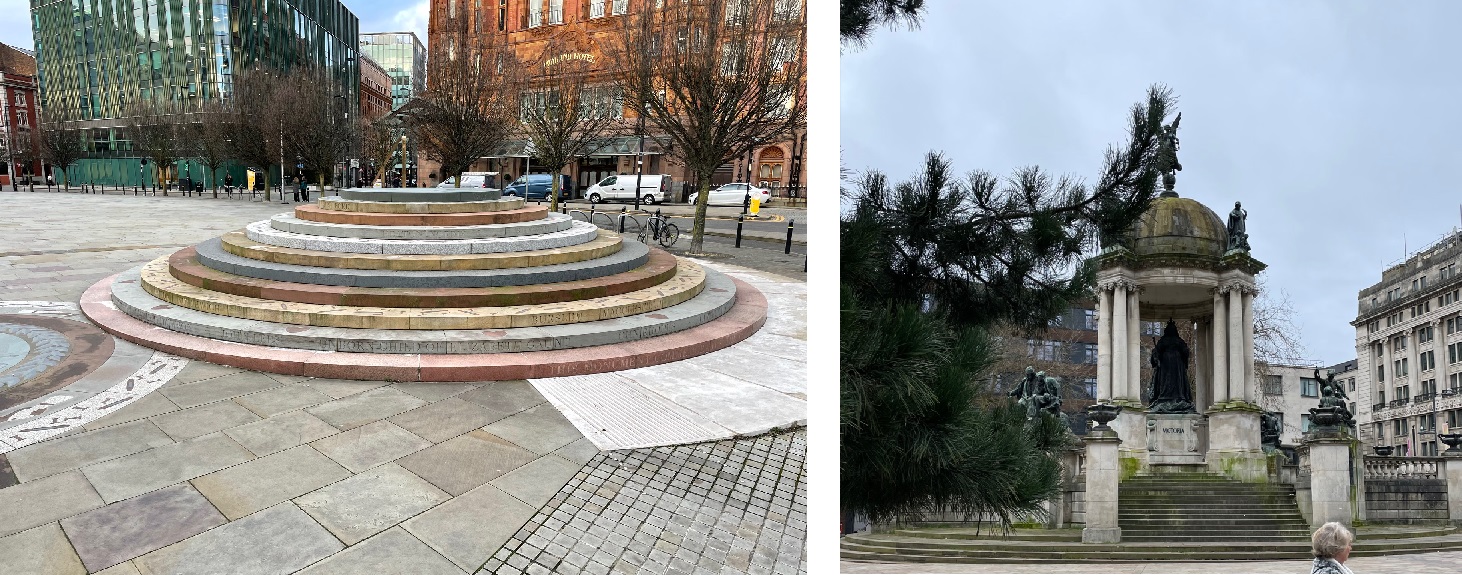Blog
“There have always been ideas worth fighting for”

- by Carla-Marinka Schorr
One can read a lot about museums and exhibitions, but going to them and experiencing them always offers something else. This is what Susannah Eckersley and I did during our one-week scoping visit to Manchester and Liverpool. In the week of the 12th of February, we visited several potential case study museums for our project. We began with the Peterloo Memorial in Manchester. In 2019, this memorial was created at the initiative of citizens, whose aim was not to forget the historic event of the so-called Peterloo Massacre on the 16th of August 1819 and in particular to remember the names of those who died during the protests. We were struck by the architectural similarity to and at the same time difference to the Queen Victoria Memorial, which we saw in Liverpool the following day: both monuments have circular steps, but in one case a single person - Queen Victoria surrounded by various allegorical figures - sits at the top of the steps and in the other the plinth is empty, the steps are inscribed with the names of real people, with arrows on the ground which point in different directions in reference to similar protests worldwide that were also violently crushed. Here we were surprised to notice similarities between two apparently very different examples – what other unexpected similarities or differences might we find at the other sites we visit? How are such connections and differentiations made evident by museums?

Here one can see both monuments in comparison: the Peterloo Massacre Memorial in Manchester (left) and the Queen Victoria Memorial in Liverpool (right). Photo: Carla-Marinka Schorr.
The Museum of Liverpool also includes many narratives of connections - for example poor living conditions in the past - and connections - such as a statue of suffragette Emmeline Pankhurst, designed by a grassroots group. At the International Slavery Museum Liverpool, we were struck by the dissonance in the connection drawn to a romanticised narrative of Africa right at the start of the exhibition, yet touched by the museum’s positioning against inhumanity and indifference - issues which continue to have an impact beyond the colonial era and still have fatal consequences for too many people today. However, we would also have liked to have seen some more concrete examples of present-day slavery, as we did at the People's History Museum in Manchester. There short videos integrated into the exhibition made it very clear how people continue to be lured abroad and enslaved with the promise of a better life and work to support their families. The permanent exhibition in the People's History Museum showcases the strengths of the weakest members of society, using the slogan "there have always been ideas worth fighting for". Accordingly - and this is where the narrative of the People's History Museum differs from that of the Museum of Liverpool - the focus is on visions and goals for a better life together. Using a slightly repetitive display style, the People's History Museum presents many individuals and the ideas which they fought for, the means and in particular the banners they used to do so, as well as how they organised themselves collectively. This created a somewhat homogenous visual impression of these heterogeneous individuals, in other words, the exhibition design also links to ideas of democracy – where individual rights and responsibilities contribute to a greater good for all. The exhibition at the Imperial War Museum North in Manchester, focuses much less on individual stories and more on large, powerful impressions. When it comes to the Second World War, exhibitions in the UK and in Germany could hardly be more different. Displaying a stone swastika, with aesthetic lighting and mounted above head height, as in the Imperial War Museum North, would most likely be inconceivable in an exhibition in Germany. The playful task set for children, to find as many swastikas as possible in the exhibits, would be scandalous in Germany.
The Manchester Museum is also very different to most museums in Germany, although in an entirely different way: with free admission for under-18s, many families pour into the exhibition galleries on this rainy Thursday morning in the half-term holiday, especially to the areas where taxidermy animals and the Golden Mummies of Egypt are on display. The newly installed showcases are bustling and teeming with visitors, and everyone finds a place for themselves thanks to the wide variety of exhibits and the large galleries. The results of artistic and schoolchildren participation on display as well as the Belonging Gallery - the main destination for our visit – both seem like a frame for the whole museum: everything you find here belongs somewhere and everyone who is here belongs here. Here visitors can explore belonging for themselves.
Our journey continued to the Pankhurst Centre, which we visited on Thursday afternoon. Similarly to the People's History Museum, the Pankhurst Centre creates an empowering atmosphere to make historical events relevant to the present day. Emmeline Pankhurst and her family are at the centre of the small exhibition in her former home in Manchester. Her energy is conveyed in an immersive audio-visual installation that uses large images and original statements from the time to emphasise what the heroine of the women's suffrage movement achieved. In a spatially-designed stand-off, the voices and statements of her mainly male opponents, have their views projected onto one side of the room, while Pankhurst’s arguments and those of her fellow campaigners are juxtaposed on the opposing wall, highlighting the contrast between the Suffragettes and the nay-sayers both in terms of space and content. Figures, data, and facts about current situations faced by many women conclude the projection and then the visitors are released into the Parlour. This room is presented as an authentic place – furnished as it would have been at the time – one that gives many visitors "goosebumps", as one of the people involved in the restoration of the building recounts in a making-of film shown at the end of the exhibition. In this, the largest and architecturally most significant room of the house, links are made between the Suffragettes and other events relevant to women's rights worldwide. The Pankhurst Centre is not just an exhibition venue or historic site, but very much a meeting place for people committed to fighting for equality, so that the democratic values of solidarity and freedom are actively lived here today.
It is clear that democracy is still alive and not merely stored somewhere dead in a museum. As a central element of our lives in the UK and in Germany, democracy is linked to the past and to the future, to historic events and to ideas still worth fighting for, as these exhibitions showed. We will take so many different impressions from our visit to Manchester and Liverpool, all of which will help to further our research on “Cultural Dynamics: Museums and Democracy in Motion”.
Last modified: Thu, 28 Mar 2024 12:53:21 GMT




